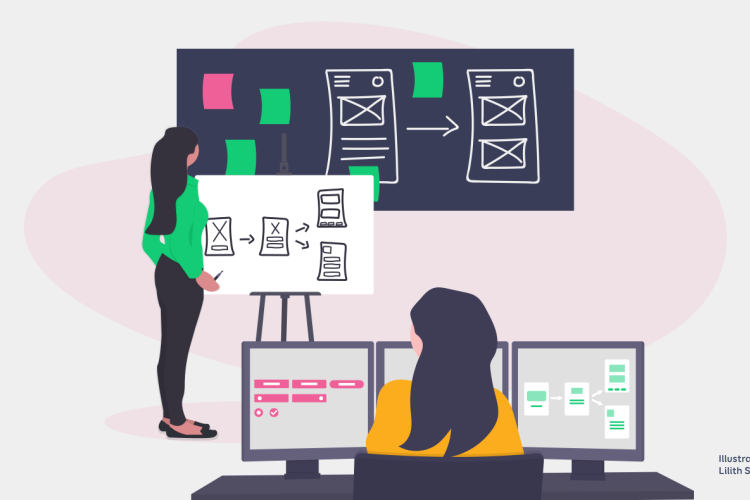Business process management
Business processes are one part of a company’s nature and the way it works. Managing them is related to activities such as defining, modelling, analysing, changing, implementing and tracking processes, and is one way of implementing change within a company. In cases where the client wishes to create change via IT solutions, it is a good idea to first check whether the business processes themselves need to be changed since IT solutions rely on business processes.
It may be possible to reach the desired outcome in the company by changing the existing business processes instead of implementing a new system. A well-conducted analysis of the business processes provides us an overview of which IT projects need to be done within the company and which ones do not. This article will give an overview of the various steps that can be taken to ensure that the business processes are managed in an all-encompassing and complete manner.
Defining and modelling business processes:
Having a clear overview of the as-is situation is prerequisite to creating change. First, we must define the processes – which ones cause the most problems, which processes are the most important for the company and its clients, which processes are most likely to be successfully changed and what would be the consequences of doing so.
Once we have done that, we can get started with modelling, which is one way of describing how a company functions and analysing its activities. We can use process models to create and communicate a common understanding of the situation. To ensure that the modelling is goal-oriented and both time and resource efficient, we should consider the following:
- Systematising the problems
In many cases, describing the problems (AKA why the company is managing these processes) will reveal half the solution. For systematising problems, it is important to describe the exact problem, which area it affects (production, IT, management, personnel…), what it affects (time, price, risk, quality, reputation…) etc. If there are multiple problems, then they need to be sorted and ordered so that they could then be resolved in order of priority.
- Gathering information about the processes
The data we need to know about the processes may be inside people’s heads or written down on paper, both inside the company as well as outside of it. You need to account for the peculiarities of how information is divided up inside the organisation.
For example, management will know about strategies and goals, while employees will know more about their instructions and other things relating directly to their jobs. You should pick a method suitable for gathering the necessary information – for example, doing interviews, organising meetings, seminars or briefings; analysing existing documentation; conducting surveys, or tracking information systems.
- Decide on the model’s level of detail
Process models are tools that can be used as a basis for creating change. A model’s level of detail is dependent on who we are creating it for and what they will use it for.
For example, if the model is aimed at the company’s management (who wishes to get a complete overview of the processes), then it is usually simpler, not overtly detailed. But if an analyst intends to use the process model for conducting an analysis (e.g. to understand and make changes to parts of the process), then the model is more detailed and technical. And if we wish to create simulations of the processes or to implement process engines, then the model will have to be created in an algorithmic form, which makes it hard to read and comprehend.
- The model’s format
Processes can be modelled using diagrams, tables, text etc. Every format has its own pros and cons, which is why they are often combined. Although text is easy to read, it is still very difficult to describe the information in an all-encompassing and structured manner with text. Creating a common understanding via text is complicated.
Diagrams as a whole are more technical and require a certain amount of experience to read, yet they enable us to convey the “big picture”. Additionally, being so structured, diagrams provide the basis for a more thorough analysis. One of the most popular notation standards for process diagrams is BPMN (Business Process Modelling Notation). This standard is known for its wealth of elements, which help to faithfully model business processes.
- The quality of the model
The quality of the models is affected by data gaps, mistakes and inconsistencies (in the use of terms), which all affect the quality of the analysis. Mistakes may, in essence, be “typographies”/syntactic and semantic (i.e. whether all of the facts and connections have been described correctly). Often, correcting technical/syntactic errors may lead to contextual mistakes, which is why it is recommended to use some kind of modelling software that helps to highlight the technical shortcomings of the models.
Analysing business processes:
Once we have modelled the business processes, we can move on to the analysis. The following describes a few points to remember when conducting the analysis:
- Leaning on the process diagram
The process is a structure that can be used to move from the problem to the root cause or from the problem to the negative result (towards the outcome of the process). While doing that, we can also evaluate what kind of value single parts or slices of the process create. The process may include activities that duplicate each other. There may be issues with the division of labour where the workflow moves from one agent to the next and in doing so, causes too many interruptions.
- Different views
Visualising the processes via different views can bring out its various dimensions which can then be handled separately. Each view has its own advantages and specific diagrams for visualising them (e.g. data flow diagrams). For example, we can depict the processes in a data-centric manner (i.e. what kind of data is changed by the processes), from the point of view of data exchange (i.e. which data is transferred by the processes), from a role-based point of view (i.e. which processes are connected to which roles) etc.
- Parameterising
We can analyse a process quantitatively. To do so, we must pick a time, price, or any other numerical parameters that are important to the project which we will then add to the model’s elements. For example, the time it takes to conduct an activity, time spent on logistics, the wait time, expenditures over time, changing costs and fixed costs, employee satisfaction, customer satisfaction etc.
We can calculate the process model as a whole or the duration of a sub-process, the workload of a role, device expenditures and so on. We can then compare various calculations (on different models, with different parameters, …). This type of quantitative analysis will clearly signal what kind of changes need to be made to the process.
Changing business processes
The previous analysis will help to reveal the bottlenecks in the current processes, such as: activities that create no added value, long wait times, going back and forth between activities etc. The changes to be implemented will be chosen based on the specific project, the problem, the resources available etc. Changes that can be implemented include removing, adding, merging, sharing, automating, and changing the order of certain activities in the processes; changing how resources are used or how data is exchanged etc. These changes can have a widespread impact on the company both internally and externally.
Implementing business processes
If modelling involves around 1-5 people, then implementation can involve 100 or more participants. Implementation of business processes can involve making changes to the company’s leadership culture, organisational behaviour, human resources management, internal communications etc.
You need answers to questions such as how big the time and resource costs of implementation are, who needs to be involved, what the potential risks are, and what the organisation’s preparedness for change is.
If a lot of people and complex dependencies are involved, then implementation may be a complicated activity that requires someone who can manage people and has previous experience with implementing change within an organisation to spearhead it all. Change is difficult and brings with it denial of the problems, and emotions.
Conclusion
Just like the environment around us changes, organisations must also be able to adapt. The success of a company depends on how quickly it is able to change. That is why business process management is a continuous, iterative activity. To reach the level of maturity where processes can be changed even faster based on the company’s needs, it is first necessary to define and then describe and measure those processes.
It is critical to ensure that the management is involved in this as they can allocate the necessary resources for this and keep the participants motivated. Unfortunately, if changes are not made, then that endangers the organisation’s sustainability.
Trinidad Wiseman has long-term experience in conducting business analyses, both for the public and private sectors. We have conducted smaller analysis projects as well as very large ones for software development projects (40 000+ work hours). In addition to business analyses, we also conduct customer requirements’ analyses, systems analyses, and detailed analyses.







